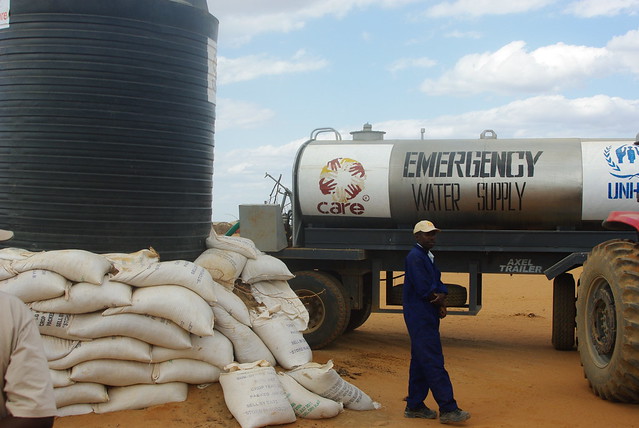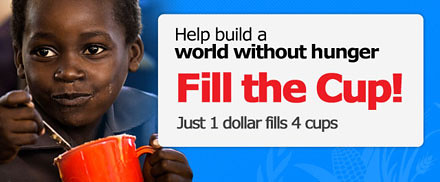As the UN reports that ongoing civil war and drought threaten all of southern-Somalia "slipping into famine," international aid agencies working in Kenya's city-sized Dadaab refugee camp have begun immunizations to prevent the spread of disease. Nearly 400,000 malnourished people residing in the camp, and thousands gathered outside the borders, are overwhelming the resources of medial workers.

Dadaab Refugee Camp, Kenya. July 2011. ©Andrew Buchanan/CARE
In an article published this morning, Euronews reports that Somalis are reporting being attacked en route to Dadaab by militant forces engaged in a five year civil war.
“We got here last night. We are attacked and all our bags were taken. We have nothing now – we hope we will get help here,” said refugee Habidya Ibrahim.
Last week, the UN announced tens of thousands of Somalis have already died as a result of four years of drought. Estimates suggest that 3.7 million Somalis are already malnourished.

Dadaab Refugee Camp, Kenya. July 2011.©Andrew Buchanan/CARE


Image from Al Jazeera "Horn of Africa Drought" coverage
East Africa Famine: 48 Hour Fundraiser
Please join us August 6 and 7 for a weekend blogathon benefit, East Africa Famine: 48 Hour Fundraiser.
Nextweek, DailyKos' EcoJustice is hosting a two-day 24/7 blogathon to raise funds for Médecins Sans Frontières to assist their work in Kenya’s Dadaab refugee camp. MSF has worked in Somali since 1991, and just yesterday announced an immediate need for medication to handle the outbreak of measles in the camp.
Also participating in this weekend of action are Oxfam International, WiserEarth,tcktcktck, deSmog Blog, MIT Climate CoLab, Climate Change: The Next Generation, MedicMobile, and RedGreenAndBlue.org. The Nonprofit Press has volunteered to send out a press release to engage more participants. Participants are selecting their own organizations for fund raising. DailyKos is raising funds to directly support the work of Médecins Sans Frontières in Kenya's Dadaab Refugee Camp.
There is one slot open in the DailyKos Blogathon, although anyone interested in participating is welcome -- we can shorten the time slots from three to two hours. A template will be available by mid-week, as will a 'badge' for placing on participants' Facebook, Twitter or Google+ accounts to show support for this benefit.
Daily Kos Lineup: ALL TIMES ARE PST
6-9 Una Spencer (introduction)
9-12 ASiegel: Reevualating "Relief" (possible topic)
12-3 rb137 (MSF overview)
3-6 wader
6-9 Jeremy Bloom
9-12:
Overnight: boatsie: Climate Change and Food Security: East Africa Focus
Sunday, August 7
6-9 blue jersey mom: Insufficient US budgeting for humanitarian foreign aid.
9-12 Jill Richardson
12-3 Ellinorianne
3-6 JekyllnHyde
6-9 Jennifer Miller Smith
9-12
Overnight: Chacounne
Ways to Participate
• Volunteer for a slot in the blogathon. We'd like as many participants as possible and can move shifts from three to two hours.
• Post the graphic (coming next week) on your site, Twitter, Google + or Facebook account to publicize your support.
• Participate in publicizing the event through social networking.
• Get in touch with your media contacts
• Let us know in comments below how you can help.

Meanwhile, detailed reporting is exploring how geopolitics, climate change, geographical sensitivities and the ravages of colonialism on indigenous cultures and livestyles have contributed to create the worst drought to impact East African nations in over sixty years.
"The drought was declared a famine when "it was no longer possible to conceal the deaths of almost 80,000 people from starvation"
In a deep investigative article, Genocidal politics and the Somali famine Al Jazeera reporter Abdi Ismail Samatar analyzes how famine occurs in a region which has long been plagued by drought.
... in the mid-1970s, there was a prolonged drought, known as "dabadeer" ["the long-tailed"], in several parts of Somalia. Fortunately, this drought did not lead to mass starvation because the Somali government moved quickly to assist the people. They mobilised the population and sought the assistance of international allies to deliver food and water to the needy.
Somalia's last major famine was in 1992 and was not caused by drought. Nearly 300,000 innocent people starved to death because of sectarian politics. The epicentre of that famine was in Bay, one of the country's most productive agricultural regions, and starvation was induced by warlords who used food as a weapon against farmers and pastoralists.
The blame for Somalia's devastating famine should not be levelled at the weather, but at geopolitics and armed militia.
(snip)
The Somali people in the affected regions have been made vulnerable to ecological disturbances because of several political and military forces. These include the US "War on Terror", the al-Shabaab terrorist group, Somalia's Transitional Federal Government (TFG), the Ethiopian invasion of Somalia and its continuous political and military involvement there, and finally East Africa's Intergovernmental Authority on Development (IGAD) and the UN.

Why Africa's Drought Is So Catastrophic
Somalis have not been governed by a central government since 1991, which has aggravated a number of the famine's contributing factors beyond the oft-cited violent conflict and drought. Over the last year, fuel and food price increases have surpassed 300 percent in the Somali capital. Regional deforestation has devastated traditional ecosystems, eliminating trees, grazing land, and water and rendering the tri-nation area "more or less dry." Much of the productive farmland has been leased to China, Saudi Arabia, and India, so desperately needed food has been exported to foreign markets. Finally, local farmers lack machinery and fertilizer, leading to low agricultural outputs and the absence of food reserves to sustain people during droughts or other shocks.
On Monday, the U.N. World Food Program (WFP) announced a plan to airlift food aid into Somalia, and the United Nations has raised $1 billion to address the issue. While this may temporarily stem the number of deaths, it is unlikely to address the economic and climatological forces underlying the disaster.
Furthermore, foreign food aid itself--while life-saving--risks exacerbating the underlying problem.
As my colleague Laurie Garrett explainedin 2009,
"79 percent of all food aid last year from wealthy countries was delivered in the form of domestically produced surplus crops, shipped via rich-country transport mechanisms...Upwards of 40 percent of all food aid spending last year was eaten up by shipping and distribution costs... Hundreds of foreign aid organizations--in the UN system, bilateral government programs, and NGOs--have tried for decades to improve agricultural production inside poor countries... Shipping food, grown by subsidized farmers toiling inside rich countries, distorts local markets not only inside famine-affected countries, but across entire regions...The longer-term impact of donated food, then, is to destroy all positive market incentives for local farmers."

Drought Threatens Health of HIV-Positive People in Africa
Severe drought in the Horn of Africa could lead to starvation for millions of people and jeopardize the health of people with HIV/AIDS, PlusNews reports. More than 11.6 million people are facing starvation in Eritrea, Djibouti, Ethiopia and Somalia. Lack of food is a widely acknowledged barrier to successful antiretroviral (ARV) therapy. A 2010 Ugandan study found that ARVs increased respondents’ appetite and that side effects were worse without food. Also, people living with HIV in pastoralist communities often share water with animals, putting them at higher risk of contracting water-borne diseases, diarrohoeal diseases, skin conditions and other opportunistic infections.

HELP! Kos EcoJustice Team Africa Top 3 Choices for Donations to Horn of Africa Crisis
• Save the Children
• MEDECINS SANS FRONTIERES/Doctors Without Borders
• The World Food Programme: Fill the Cup: (THE WFP needs $200 million just to meet this year's needs in the Horn of Africa.)
ADDITIONAL IDEAS
• Care International
• UNICEF: Donate to Save Children in Horn of Africa Crisis
• FreeRice- donates 10 grains of rice to the WFP for each answer you answer correctly.
• The HungerSite - Click to give free food.
• WFT: 10 Ways You Can Help
Horn of Africa Drought Facts (combined sources)
• More than 12 million people are affected in Somalia, Kenya, Djibouti, Sudan and Uganda
• Nearly half of Somalia's population is facing a humanitarian crisis - almost 3.7 million people
• Over 2 million children under the age of five who are suffering from malnutrition; 480,000 are severely malnourished
• UN declares famine in two districts- Bakool and Lower Shabelle - in southern Somalia; anticipates spread of famine throughout the entire southern Somalia region.
• Women are disproportionally affected by the drought as they are the last to eat when food is limited.
• Aid response nearly $1 billion short of what is needed
• Immunizations have begun in Daab Refugee camp, where medical teams are in serious need of additional supplies.
• Over $1bn has been committed but a further $1bn is still required to save thousands of lives
What is a Famine
Most major aid agencies - the FAO, the WFP, the Famine Early Warning Systems Network, Save the Children UK, CARE International, the European Commission Joint Research Centre and Oxfam - only describe a crisis as a famine when the situation on the ground reaches level five on the Integrated Phase Classification (IPC) system. This means:
* at least 20% of the population has access to fewer than 2,100 kilocalories of food a day
* acute malnutrition in more than 30% of children
* two deaths per 10,000 people, or four child deaths per 10,000 children every day
Famine Scales
Magnitude scale:
Category A: Minor Famine: 0-999
Category B: Moderate famine Mortality Range:1,000-9,999
Category C: Major famine 10,000-99,999
Category D Great famine 100,000-999,999
Category E Catastrophic famine 1,000,000 and over
Resources
•BBC: What you Need to Know
• Q&A: BBC
• Al Jazeera Horn of Africa (english)
• How Bad is the Horn of Africa Drought: AlertNet Q&A:
• PBS Newshour: PhotoEssay: 7/11
• Guardian Interactive Horn of Africa Drought Map
• Why doesn't a drought go away when it rains?
• Oxfam: Food crisis in Wajir, Kenya
• Fighting Famine in Southern Africa: Steps out of the Crisis. The International Food Policy Research Institute (IFPRI) recently released a report outlining sustainable options for ending hunger and poverty, tailored to address famine in Africa.

Coverage @ KOS
This is the latest in a series of diaries covering the Horn Of Africa Crisis. Please visit previous entries at the Ecojustice Group.
Social Media
Twitter: #HornofAfrica, #drought, #famine
Facebook: Horn of Africa
MapSourcing
Regional Drought Response Plan: East Africa Droughts.


